Laboratory moves into new era with a new name
No Sweat for Fanic Conference Crew
ARC Ceremony Marks Beginning of Construction and Partnerships
DOE Site Office Works to Maintain Contract and Communications
Man With a Vision
Quality Advisor Council Takes Action
New ATM On-Site
Education Forum Led by O'Leary
Dedicated to Greatness
Laboratory moves into new era with a new name
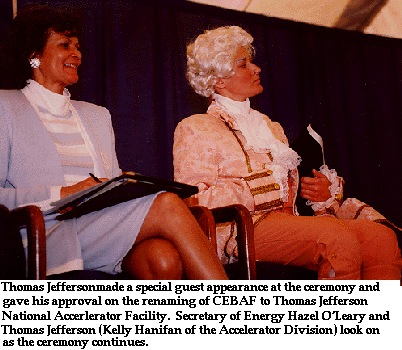
"It is a great day to be alive in the Commonwealth." That is what Dana Hamel, SURA Vice President and Chancellor Emeritus of the Virginia Community College System, said on May 24, 1996. It certainly was a great day because CEBAF was officially dedicated and renamed the Thomas Jefferson National Accelerator Facility. As the York River Band played and Lisa Spruill of the Accelerator division sang, Jefferson Lab staff, users, family members, business leaders, and politicians gathered under a tent in the CEBAF Center parking lot to celebrate a new era of experimentation.
Guest speakers spoke of the enormous determination and success that went into making Jefferson Lab a reality. James McCarthy was recognized for his vision of creating an accelerator, and then turning that vision into a concrete proposal. His proposal was chosen because of its ability to be upgraded to higher energies in the future and because its conservative design offered the most assurance that the machine would work.
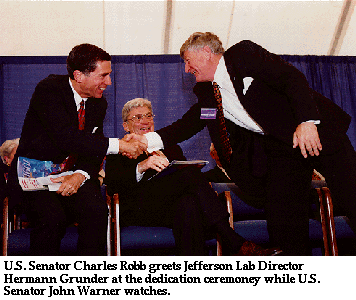 Martin Perl, 1995 Nobel Laureate for Physics, challenged experimenters to make new discoveries and not to be discouraged by the hardness of nature. "This lab is a new tool for investigating nature. The experimentation done here is what leads to knowledge. Even experiments that fail give you new ideas and information," said Perl.
Martin Perl, 1995 Nobel Laureate for Physics, challenged experimenters to make new discoveries and not to be discouraged by the hardness of nature. "This lab is a new tool for investigating nature. The experimentation done here is what leads to knowledge. Even experiments that fail give you new ideas and information," said Perl.
Jefferson Lab Director, Hemann Grunder, received a standing ovation from the crowd upon being introduced. Grunder thanked everyone who contributed to making the lab a success, and acknowledged the families who endured "late evenings, cancelled vacations, and missed ballgames." Grunder said the lab was built for the best minds in the world, and the success that Jefferson Lab has witnessed is "a result of partnerships that complement and promote science." Grunder concluded his speech by pledging himself to this partnership and by inviting everyone to do the same.
Keynote speaker, U.S. Secretary of Energy Hazel O'Leary delivered an inspirational message stressing the importance of the discoveries being made at Jefferson Lab and the necessity to share knowledge with the public. "The general public feels pride in this facility but they are not sure why," said O'Leary. "The leap of faith the public must take is, 'Having gained knowledge, what value is it?'" O'Leary applauded Jefferson Lab's educational outreach and the influence it has had on the lives of local students. She called a few of them on stage to help her unveil the new name and logo.
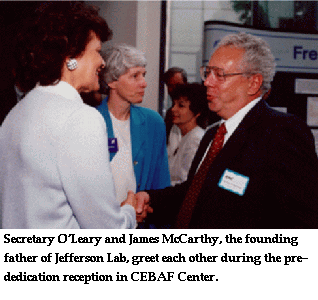 Secretary O'Leary was joined on stage by local, state, and federal politicians who were all instrumental in the development of Jefferson Lab. Master of Ceremonies Dennis Barnes, President of SURA, acknowledged Senators Charles Robb and John Warner for their support of Jefferson Lab in Congress. Representatives Herb Bateman and Bobby Scott were thanked for their efforts which brought the lab to Newport News. The city's Vice Mayor, Joe Frank, was acknowledged for his support of the lab on the local government level.
Secretary O'Leary was joined on stage by local, state, and federal politicians who were all instrumental in the development of Jefferson Lab. Master of Ceremonies Dennis Barnes, President of SURA, acknowledged Senators Charles Robb and John Warner for their support of Jefferson Lab in Congress. Representatives Herb Bateman and Bobby Scott were thanked for their efforts which brought the lab to Newport News. The city's Vice Mayor, Joe Frank, was acknowledged for his support of the lab on the local government level.
The dedication of CEBAF and its name change to Jefferson Lab marks the end of construction and the beginning of experimentation. "The dedication signifies the official opening of the lab as a scientific facility. Before, we were a construction project. Now we are an operating scientific facility," said Nathan Isgur, Jefferson Lab Theory Group Leader. Throughout the day, people congratulated each other on accomplishing something that has never been done before-building a complex machine that probes the nucleus of the atom using a continuous stream of electrons.
Rebecca James, Director's Office Intern
No Sweat For PANIC Conference Crew
Did someone say "panic"? The 14th International Conference on Particles and Nuclei is history, to the great relief of all concerned. Jointly sponsored by Jefferson Lab and the College of William and Mary, the conference brought 600 physicists to Williamsburg for seven days this May. The purpose of this triennial event is to keep scientists up to date on advances in physics at the borderline between nuclear physics and particle physics.
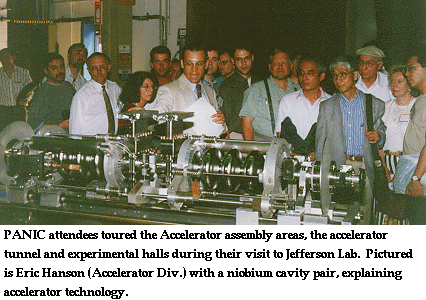 John Domingo, Jefferson Lab Associate Director, Physics Division, and Carl Carlson, William and Mary Department of Physics, served as co-chairs for the conference. Attendees were welcomed at the opening session by Jefferson Lab Director Hermann Grunder and William and Mary President Timothy Sullivan. Hailing from five continents, more than 23 countries and 28 states, conference participants presented, discussed, argued and, occasionally, listened to each other from May 22 through May 28.
John Domingo, Jefferson Lab Associate Director, Physics Division, and Carl Carlson, William and Mary Department of Physics, served as co-chairs for the conference. Attendees were welcomed at the opening session by Jefferson Lab Director Hermann Grunder and William and Mary President Timothy Sullivan. Hailing from five continents, more than 23 countries and 28 states, conference participants presented, discussed, argued and, occasionally, listened to each other from May 22 through May 28.
Based on enthusiastic feedback from participants, the conference was a resounding success on all fronts. "There were several good talks," says Domingo. "The plenary speakers were exceptionally good." Morning plenary talks by 23 invited speakers were held in Phi Beta Kappa Hall. Afternoon sessions at University Center were devoted to parallel talks-246 oral presentations on 12 topics, selected from the 674 total abstracts submitted. More than 400 posters were displayed simultaneously throughout the conference at William and Mary Hall.
"I was exhilarated by the conference," co-chair Carlson said. "After a long time worrying that no one would come, that nothing would work, there was a definite moment about a week and a half before the conference when my mood changed. I went from worrying about it to being excited about it. It was clear to me that it was all going to work. And it did."
Orchestrating an event of such monumental proportions required more than a year of intensive planning, organizing and just plain hard work. "The real challenge for all of us was not to organize this conference," explains Marty Hightower, chair of the LOC, "but to come out of it with our sanity and sense of humor intact." LOC members were, from Jefferson Lab: Ruth Bizot, Sue Ewing, Cindy Garwood, Karen Hokansson, Julie Leverenz and Janet Prater; from William and Mary physics department: Morty Eckhause and Dirk Walecka; and from William and Mary Conference Services, Bob Jeffrey and Bill Tian.
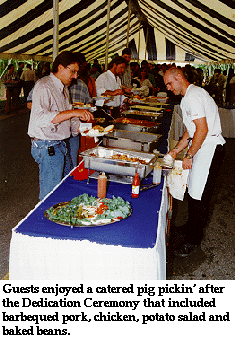 From break-out sessions, buses and box lunches to overhead projectors and on-line access, the array of logistical details required for a conference of this size is staggering. Mailing lists had to be researched, acquired and transformed into a comprehensive database. Posters, programs and flyers were designed, printed and mailed. Hotel accommodations, travel arrangements, student support, poster boards, menus, e-mail responses, abstract booklets and proceedings-the list was nearly endless.
From break-out sessions, buses and box lunches to overhead projectors and on-line access, the array of logistical details required for a conference of this size is staggering. Mailing lists had to be researched, acquired and transformed into a comprehensive database. Posters, programs and flyers were designed, printed and mailed. Hotel accommodations, travel arrangements, student support, poster boards, menus, e-mail responses, abstract booklets and proceedings-the list was nearly endless.
Mere weeks before the conference began, the Jefferson Lab Dedication date was scheduled to coincide with what was originally the PANIC Pig Pickin'. Working simultaneously on two such major events required, at times, 'round-the-clock effort. "I'm most impressed with the incredible team effort of everyone concerned," Hightower says. "I've never seen people push themselves quite so hard to reach a common goal."
As for the physicists, they came, they talked, they ate. By the time the conference was over, attendees had generated more than 200,000 words (not counting breaks), consumed nearly 10,000 meals and drunk in excess of 16,000 cups of coffee. But it wasn't all work and no play. Ample change-of-pace opportunities were offered at regular intervals. On Saturday night, archaeologist Nicholas Luccketti gave a slide presentation on the recent re-discovery of the original Jamestown site. Sunday evening offered music lovers a double-header featuring Colonial Williamsburg's own The Governor's Musick, and the contemporary, high-tech sounds of The Dominion Trio. The Hilton Brass drove the drizzle away at Monday's SeaFest in William and Mary's Sunken Garden, while The Good Life Band did up-tempo honors at the Pig Pickin'.
Ironically, neither Carlson nor Domingo were the ones who, six years ago, volunteered their respective institutions as hosts for PANIC. "Do you think I'm totally nuts?" said Domingo. "Jefferson Lab had already volunteered for the conference. I had no choice." But the bright side, he points out, is that given its current rotation schedule, the conference won't be back in this neck of the woods for a long time. "I'll be 81," said Domingo, " It's unlikely I'll have to do it again."
The conference was also a fiscal success. Though the final financial reporting has not yet been completed, already it seems clear that the bottom line is comfortably in the black. In addition to registration fees and major support from Jefferson Lab and DOE, funding sources included grants from the National Science Foundation, the International Union of Pure and Applied Physics, LeCroy Research Systems, Los Alamos National Laboratory and BiRa Systems.
At the close of this year's conference, Uppsala University in Sweden was chosen to host PANIC '99. All we can say to them is-Don't Panic.
Ruth Bizot, Conference Services Administrator
ARC Ceremony Marks Beginning of Construction and Partnerships
For any project to be successful, the cooperation of all involved is necessary. On Thursday, May 9, 1996, as the ground was being broken at Jefferson Lab for the new Applied Research Center (ARC), cooperation was the buzz word on everyone's lips.
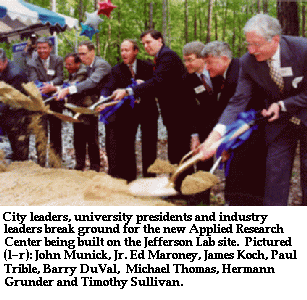 The ground breaking for the ARC building is the dawning of an era of cooperation among industry, government, and universities. "The ARC building is not only giving us space, it is giving us valuable space where universities and Jefferson Lab staff can interact," said Jefferson Lab director, Hermann Grunder. The 120,000 square foot building will be leased in part by three local universities, Jefferson Lab, and industries. Christopher Newport University, Old Dominion University, and the College of William and Mary have committed to leasing 30,000 square feet for research, development activities, and graduate training. Jefferson Lab has committed to leasing 35,000 square feet,and the Newport News Industrial Development Authority has reserved the remaining space for future industry partners.
The ground breaking for the ARC building is the dawning of an era of cooperation among industry, government, and universities. "The ARC building is not only giving us space, it is giving us valuable space where universities and Jefferson Lab staff can interact," said Jefferson Lab director, Hermann Grunder. The 120,000 square foot building will be leased in part by three local universities, Jefferson Lab, and industries. Christopher Newport University, Old Dominion University, and the College of William and Mary have committed to leasing 30,000 square feet for research, development activities, and graduate training. Jefferson Lab has committed to leasing 35,000 square feet,and the Newport News Industrial Development Authority has reserved the remaining space for future industry partners.
The ceremony was led by Paul Miller, Director of Planning and Development for the City of Newport News, and featured speakers who were all instrumental in bringing the idea of the ARC building to fruition. All of the speakers stressed the importance of working together to make the City of Newport News and Hampton Roads a competitor in research and industry. "This building creates a clear understanding that Hampton Roads is on the cutting edge of technology," said Timothy Sullivan, President of the College of William and Mary.
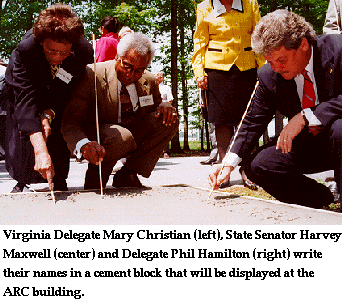 City leaders are hoping the ARC building will attract state-of-the-art commercial businesses to this area. According to Newport News Vice Mayor, Joe Frank, attracting these businesses has the potential to change Newport News' reputation. "These businesses and scientific growth can change our city's blue collar image," says Frank. Newport News Mayor Barry Duval echoed Frank's statement saying, "The ARC building will bring the best minds in the world together to create better products and better service."
City leaders are hoping the ARC building will attract state-of-the-art commercial businesses to this area. According to Newport News Vice Mayor, Joe Frank, attracting these businesses has the potential to change Newport News' reputation. "These businesses and scientific growth can change our city's blue collar image," says Frank. Newport News Mayor Barry Duval echoed Frank's statement saying, "The ARC building will bring the best minds in the world together to create better products and better service."
Underlying this cooperation among Jefferson Lab, industry, and universities is Jefferson Lab's Free Electron Laser Program. The FEL is a manufacturing tool using laser light. It will be used in industry as a powerful, versatile source for products involving fiber, films, metals, ceramics, and electronic materials. Each university will contribute to the laser program through research, laboratory facilities, and information systems. The ground breaking of the ARC building is a major step in the right direction for getting the FEL "off the ground."
Rebecca James, Director's Office Intern
DOE Site Office Works to Maintain Contract and Communications
It's nice to know that Jefferson Lab has friends in high places. The employees of the Department of Energy (DOE) Site Office are looking out for Jefferson Lab in Washington, D.C. when it comes to budget, community relations, issue resolution, and aid to the facility. Under the jurisdiction of the Oak Ridge Operations Office and DOE's Division of Nuclear Physics within the Office of Energy Research, the DOE Site Office is responsible for negotiating and administering the DOE contract with SURA for managing and operating Jefferson Lab. They are also responsible for ensuring that all activities performed on site are done in a way that protects the environment, workers, and the public. Their ultimate goal is to do what it takes to make Jefferson Lab a world class institution for nuclear physics research, technology development, and education.
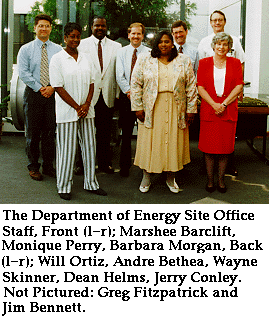 Established in 1986, the DOE Site Office has played an integral part in this facility being built on time and under budget. "Part of our job is to facilitate through the government so that the processes here are being accomplished in the most efficient way," says Jerry Conley, Deputy Site Office Manager. The performance-based contract between SURA and DOE defines the requirements for SURA's management and operation of this laboratory ranging from finance to construction of the experimental halls and other facilities. As representatives of DOE, the Site Office has full contractual authority and is able to make immediate decisions that are in the best interest of the Laboratory. "What makes us different from other site offices is that we have the authority to sign and modify the contract between SURA and DOE here on site," says Wayne Skinner, the Site Office's Business Manager/Contracting Officer. Although contract modifications affecting DOE policy must be coordinated with other Departmental elements, this on site authority eliminates the need to pass all issues through Oak Ridge and Washington, D.C.-allowing for decisions to be made in a timely manner.
Established in 1986, the DOE Site Office has played an integral part in this facility being built on time and under budget. "Part of our job is to facilitate through the government so that the processes here are being accomplished in the most efficient way," says Jerry Conley, Deputy Site Office Manager. The performance-based contract between SURA and DOE defines the requirements for SURA's management and operation of this laboratory ranging from finance to construction of the experimental halls and other facilities. As representatives of DOE, the Site Office has full contractual authority and is able to make immediate decisions that are in the best interest of the Laboratory. "What makes us different from other site offices is that we have the authority to sign and modify the contract between SURA and DOE here on site," says Wayne Skinner, the Site Office's Business Manager/Contracting Officer. Although contract modifications affecting DOE policy must be coordinated with other Departmental elements, this on site authority eliminates the need to pass all issues through Oak Ridge and Washington, D.C.-allowing for decisions to be made in a timely manner.
In instances when advice is needed from elsewhere in DOE, the Site Office acts as an intermediary for SURA and Jefferson Lab. "Whenever SURA has an issue that needs to be addressed, they can meet with us 'on site' to discuss the issue, and depending on the political sensitivities, we may need to seek advice from Headquarters or Oak Ridge prior to arriving at a decision," said Skinner. As the intermediary between DOE and SURA, the Site Office provides a valuable service by interpreting and advocating the needs of the laboratory and eliminating the need for SURA to work directly with Oak Ridge and Headquarters. "If we were not here on site, SURA would have to work primarily with Oak Ridge. Because of the long distance, communications would be more difficult with added work for SURA," said Barbara Morgan, the Site Office's Environment, Safety, and Health Manager.
The DOE Site Office is also responsible for ensuring that the employees of Jefferson Lab have a safe and healthy work environment. The Site Office works closely with the laboratory's EH&S personnel to guarantee that the laboratory's activities comply with federal and state EH&S laws. Morgan acts as a liaison between Jefferson Lab and regulatory agencies for permit purposes. "The Site Office ensures that the functions here are carried out in a manner that protects the government, Jefferson Lab personnel, the general public, and the environment from hazards arising from the work performed at the laboratory," says Morgan.
Prior to July 1995, the DOE Site Office spent considerable time overseeing the construction and management of Jefferson Lab under a contract that detailed the overall requirements of the work being done here. In July 1995, with the end of construction nearing, the Site Office represented the DOE in negotiating a new contract with SURA that emphasizes performance-based management. "Our new performance-based management contract implements the provisions of the Department's Contract Reform Report and moves the Department into a 'performance' rather than a 'compliance' oversight basis at Jefferson Lab," said Skinner. This contract clearly details all areas in which Jefferson Lab is evaluated and awards points for successful operation. "The negotiated Performance Metrics in Appendix B of our contract evaluate the 8 critical areas of performance, ranging from: Science and Technology, Operations, Scientific and Technical Manpower, Technology Transfer, ES&H, Business Management, Public Outreach and Institutional Management," says Skinner.
In addition to assessing Jefferson Lab's management, the Site Office is working closely with SURA and the DOE Office of Energy Research representatives to develop and implement an effective evaluation system for Jefferson Lab's Science and Technology program as provided by the new contract. To do this, great reliance will be placed on help from scientific experts using the peer review process. During July 16-18, the first Science and Technology Peer Review will be held at Jefferson Lab where a panel consisting of scientists and other Jefferson Lab peers will review how well the Laboratory is meeting the needs of its users in the experimental program, and performing in other scientific and technological areas including theory, accelerator R&D, and technology transfer programs.
Rebecca James, Director's Office Intern
Dean Helms: Man With a Vision
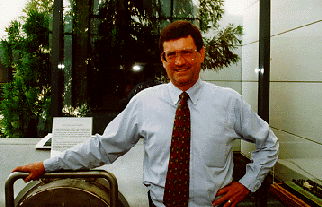 The first thing Dean Helms sees when he walks into his office each morning is a vivid reminder of his purpose at Jefferson Lab. During the day, this reminder is constantly in front of Helms' face. Flashing brightly across his computer screen is the question, "How does this contribute to the vision?" The question is intended as a challenge that all activities performed during the day should add value and contribute to the achievement of the vision. This vision motivates Helms, the Department of Energy Site Office Manager, to make Jefferson Lab an excellent scientific asset for its users, the Department of Energy, and the nation.
The first thing Dean Helms sees when he walks into his office each morning is a vivid reminder of his purpose at Jefferson Lab. During the day, this reminder is constantly in front of Helms' face. Flashing brightly across his computer screen is the question, "How does this contribute to the vision?" The question is intended as a challenge that all activities performed during the day should add value and contribute to the achievement of the vision. This vision motivates Helms, the Department of Energy Site Office Manager, to make Jefferson Lab an excellent scientific asset for its users, the Department of Energy, and the nation.
Helms' career with the DOE began following his education at Duke University and the University of North Carolina at Chapel Hill. After graduation, Helms was recruited by the Atomic Energy Commission (a predecessor to the Department of Energy) for a management intern program. The program was designed for new college graduates to provide entry level management positions for careers with the government. This opportunity has led to a 30 year career with the DOE and the chance to work at sites in South Carolina, New Mexico, Washington, D.C., and finally Newport News.
As the DOE Site Office Manager since 1988, Helms is responsible for ensuring that all parties involved in the laboratory have a clear understanding of its mission and goals. "My job is to team with Dennis Barnes, president of SURA, Hermann Grunder, the program officials in Washington, and the Oak Ridge people to make sure that we have a constructive partnership and that we all understand the goals and objectives of Jefferson Lab," said Helms. "We also have to have a common understanding of the best strategies for achieving those goals". Recently, Helms was instrumental in getting a document called "Partnership Principles" signed by the DOE and SURA. "Partnership Principles" is a framework that outlines how the DOE and SURA are going to work together to achieve what is in the best interest of Jefferson Lab and DOE. "Hopefully these guidelines and principles will help define our roles and facilitate solutions and approaches to implementing new initiatives," says Helms. "It will also be very useful in developing future courses of action."
During Helms 30 year career with the DOE, he has worked with many senior officials and managers. Through previous positions in Washington, he has an infinite awareness of both the history and the structure of the DOE. He has also established an unshakable credibility within the DOE. Helms' extensive knowledge of how the DOE works makes him a valuable asset to Jefferson Lab. "My value to the lab has been enhanced by the knowledge I have of the people and of how decisions are made within the DOE," says Helms. "When an issue arises at Jefferson Lab, my background tells me who within the DOE is the best person to go to for a resolution." This knowledge of the inner workings of the DOE helps to avoid messy issues or resolve them in a timely manner.
Issue resolution is not Helms' only area of expertise. As a representative of the DOE, Helms works closely with Jefferson Lab director, Hermann Grunder in providing a unified front to the local community and to others with whom the lab interacts. "Hermann and I feel that it is important for the DOE and Jefferson Lab to work and stand together," says Helms. "When we have visitors, for example, it is important for them to see someone from the DOE present and enthusiastic about the work being done here."
When Helms is not working, he enjoys traveling with his wife, Susan. They have been to England, Germany, Austria, Switzerland, Mexico, Hungary, Canada, and Australia. During his visit to Queensland, Australia, Helms had to get use to the climate getting warmer when traveling north and cooler when traveling south.
Helms says that his journeys overseas benefit his performance as DOE Site Office Manager. His exposure to other countries and the values they hold enable him to interact successfully with the many foreign visitors who come to Jefferson Lab.
Rebecca James, Director's Office Intern
Dedication Memories
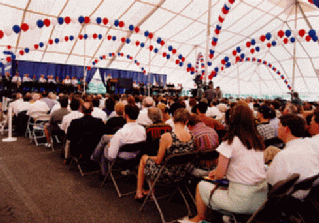 Two thousand guests listen as featured speakers talk about Jefferson Lab's past, present and future as a national laboratory. |
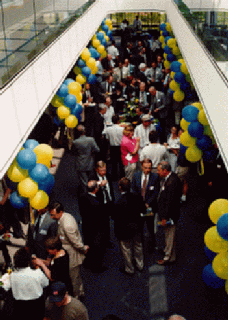 Guests were treated to a pre-dedication reception in CEBAF Center where they sipped sparkling cider and enjoyed hor d'oeuvres. |
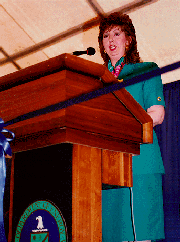 Lisa Spruill of the Accelerator Division sings a beautiful rendition of the national anthem at the Dedication Ceremony. |
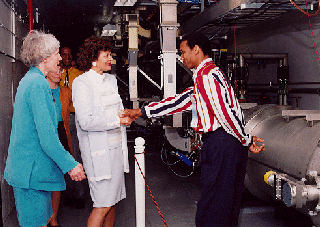 Secretary O'Leary and Associate Director of Project Management Beverly Hartline greet Phil Adderly of the Accelerator Division during a tour of the South Linac. |
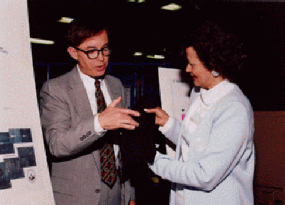 Michael Kelley of DuPont explains the Free Electron Laser project to Secretary O'Leary. |
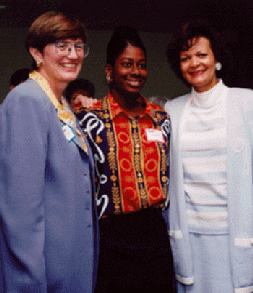 Pictured left to right are Martha Krebs, Director of Energy Research for the U.S. Department of Energy, Marshee Barclift, student intern in the DOE Site Office and the Honorable Hazel O'Leary, U.S. Secretary of Energy |
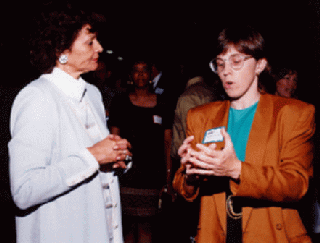 Betsy Beise, Chair of the Jefferson Lab User Group Board of Directors, explains the mechanics of Hall A to Secretary O'Leary. |
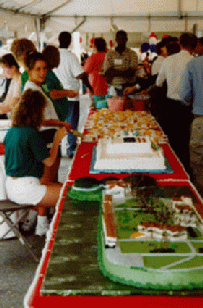 At the Pig Roast, guests enjoyed cake modeled after the accelerator site. |
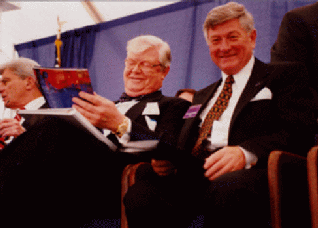 Herman Grunder, Jefferson Lab Director and D. Alan Bromley, Sterling Professor of Sciences at Yale University, share a laugh before the ceremony begins. |
|
BRIEFLY . . .
Quality Advisor Council Takes Action
Jefferson Lab's Quality Advisory Council has developed a new charge for the group, which describes a new, more active, high-profile role. The charge describes a role that recognizes the need for a cross-cutting group to bring issues of lab-wide interest to the Director's Council.
Since the Director's Council approved the charge about a month ago, the QAC has recommended the formation of two teams to address lab-wide issues. These two issues had first surfaced as part of an informal survey done by the first QAC two years ago. The first team, championed by Christoph Leemann and chaired by Brian Murphy will examine the training and education opportunities for technical staff at Jefferson Lab in order to make recommendations that will make these types of programs more accessible. The team consists of 13 members selected from various technical disciplines throughout the Physics and Accelerator Divisions. The second team chaired by Karen Hokannson and championed by Beverly Hartline will look at communication throughout the lab and how the information flow can be improved.
The Quality Advisory Council has also established an e-mail address, qac@jlab.org, so that anyone on site with concerns or feedback can reach the group. They have established an area in the library for quality-related resources, and have a new page on the World-Wide Web that will increase their visibility in the lab and provide up-to-date information on QAC initiatives. "We want to hear from people at the lab about their problems and concerns. Without that input, the QAC cannot be effective," emphasizes Brian Murphy.
The terms of several of the current members of the QAC will eventually expire, and the group is looking for interested individuals throughout the lab who can be considered for membership on the Council. "It takes a lot of time, but it is really worth it," says QAC Chair Brian Murphy, "The council has a real chance to take all the words we've heard about quality and turn them into actions that will make a real difference at Jefferson Lab".
New ATM On-Site
No more mad dashes to the bank! A great idea submitted by Teresa Beatty of Project Management to the Jefferson Lab Employee Suggestion Program has resulted in a new automatic teller machine (ATM) in the VARC building lobby.
The ATM is from the Langley Federal Credit Union. All members of LFCU can make withdrawals, check account balances, and make transfers from their LFCU accounts at no charge without leaving the site. For a fee, the ATM will also accept Honor, AFFN, Diner's Club, Exchange, VISA, Cirrus, Mastercard, Plus, Discover, and American Express. For more information, call Human Resources at ext. 7502.
Training Update
In an effort to serve as an important partner in the success of the laboratory, the Human Resources and Services (HR&S) Department is committed to assist in the professional development of each employee. To support this objective, we have instituted the following procedures or services to better serve you, our customer.
Computer Training: Human Resources has purchased vouchers for computer training from PROSOFT at a reduced rate. Laboratory employees are eligible to use these vouchers for all day basic PC training courses at a cost of $65.00 per day. (These vouchers may not be used for higher level courses such as UNIX, NetWork, or Internet classes.) A schedule of classes at the Newport News or Virginia Beach Training Center is posted on the Training and Development bulletin board in VARC next to Human Resources and is available in the Training and Development Office, VARC, room 21. To purchase a voucher, complete a Training Authorization Form. A copy of the form is available for site-wide access on the NT Server, CCNT1. In the directory HR_Share is a FORMS directory with two subdirectories: APP_FORM and HR_FORMS. Training forms are located under the HR_FORMS subdirectory.
Off-Site Training: Lab policy requires that any off-site training of a non-technical nature, for example supervisory/management, communication or interpersonal skills be approved by the Training and Development Manager before one registers for training. This is accomplished by completing and forwarding to the Training and Development Manager a SURA Job-Related Training Request form which is available on the NT Server, CCNT1. The completed SURA Job-Related Training Request form must accompany the Travel Request form to Finance. The purpose of the form is to provide Training and Development the opportunity to be a resource to laboratory staff by recommending possible training options. Many of these options are based on the evaluations completed by staff who have participated in prior training courses. The Evaluation of Outside Training Program form, which is completed at the end of training, documents the value of the training and becomes a resource for evaluating future requests for potential participants.
American Management Association (AMA): Human Resources is a corporate member of the American Management Association (AMA). As a corporate member, laboratory staff are eligible for the reduced rate for training seminars, workshops, and conferences. Contact Brittany Davis (ext. 5858) for the corporate membership number when registering for an AMA activity.
Bill Williams, HR Training and Development Manager
Education Forum Led by O'Leary
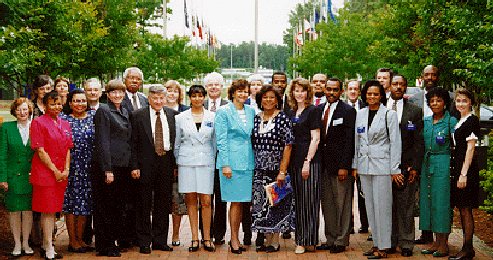
Secretary of Energy Hazel O'Leary met with educational leaders from the community at Jefferson Lab on Saturday May 15, 1996, to discuss fostering math and science education in the Tidewater area. The Community Education Forum included representatives from area universities and local public schools who send their students to Jefferson Lab to participate in its k-12 education program and its undergraduate student intern program. "This forum clarified for all participants the uniqueness, value, and quality of our involvement in education at all levels, and Jefferson Lab's importance as a resource to the community," said Beverly Hartline, Associate Director for Project Management and forum participant. Many participants gave testimonials about their experiences at Jefferson Lab and the benefits of its science education programs for both teachers and students. The forum vowed to meet again in the future to discuss implementing five priorities for science education.

